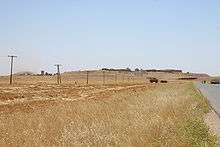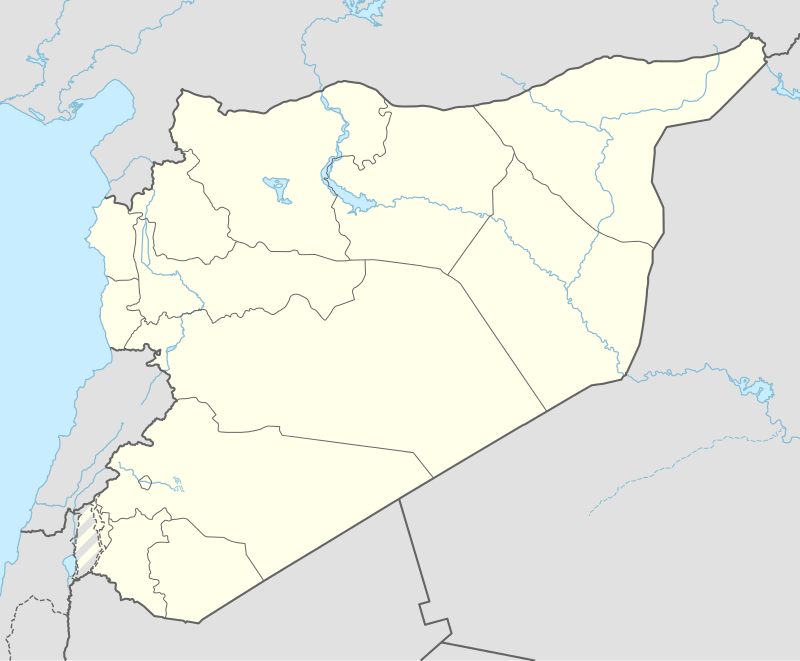Tell Leilan
 View of Tell Leilan | |
 Shown within Syria | |
| Location | Al-Hasakah Governorate, Syria |
|---|---|
| Region | Assyria |
| Coordinates | 36°57′26″N 41°30′19″E / 36.95722°N 41.50528°ECoordinates: 36°57′26″N 41°30′19″E / 36.95722°N 41.50528°E |
| Type | Settlement |
| History | |
| Founded | 5000 BCE |
| Abandoned | 1726 BCE |
| Cultures | Akkadian, Assyrian |
| Site notes | |
| Condition | In ruins |
Tell Leilan is an archaeological site situated near the Wadi Jarrah in the Khabur River basin in Al-Hasakah Governorate, northeastern Syria, a region formerly a part of ancient Assyria. The site has been occupied since the 5th millennium BC. During the late third millennium, the site was known as Shekhna. During that time it was under control of the Akkadian Empire. [1] Around 1800 BC, the site was renamed "Shubat-Enlil" by the Assyrian king, Shamshi-Adad I and it became the capital of Assyria in northern Mesopotamia. Shubat-Enlil was abandoned around 1700 BC.
Geography
The site is located close to some other flourishing cities of the time. Hamoukar is about 50 km away to the southeast. Tell Brak is about 50 km away to the southwest, and also in the Khabur River basin. Tell Mozan (Urkesh) is about 50 km to the west.
Leilan, Brak and Urkesh were particularly prominent during the Akkadian period.[2]
History
The city originated around 5000 BC as a small farming village and grew to be a large city ca. 2600 BC, three hundred years before the Akkadian Empire. A 3-foot layer of sediment at Tell Leilan containing no evidence of human habitation offered clues as to the cause of the demise of the Akkadian imperial city; analysis indicated that at around 2200 BC, a three-century drought was severe enough to affect agriculture and settlement.[3][4][5][6]
Shubat-Enlil
| Kingdom of Upper Mesopotamia Kingdom of Upper Mesopotamia | |||||||||
|---|---|---|---|---|---|---|---|---|---|
| circa 1809 BCE–circa 1776 BCE | |||||||||
| Capital | Shubat-Enlil | ||||||||
| Government | Monarchy | ||||||||
| King | |||||||||
• circa 1809 BCE – 1776 circa BCE | Shamshi-Adad I | ||||||||
| Historical era | Bronze Age | ||||||||
• Established | circa 1809 BCE | ||||||||
• Disestablished | circa 1776 BCE | ||||||||
| |||||||||
| Today part of |
| ||||||||
The conquest of the region by Shamshi-Adad I (1813–1781 BC) of Assyria revived the abandoned site of Tell Leilan. Shamshi-Adad saw the great potential in the rich agricultural production of the region and made it the capital city of his empire. He renamed it from Shehna to Shubat-Enlil, or Šubat-Enlil, meaning "the residence of the god Enlil" in the Akkadian language.[7] In the city a royal palace was built and a temple acropolis to which a straight paved street led from the city gate. There was also a planned residential area and the entire city was enclosed by a wall. The city size was about 90 hectares (220 acres). Shubat-Enlil may have had a population of 20,000 people at its peak. After the death of Shamsh-Adad, the city became the capital of Apum and prospered until king Samsu-iluna of Babylon sacked it in 1726 BC in an attempt to maintain Babylonia's failing influence over Assyria. The Babylonians were defeated driven out of Assyria by the Assyrian king Adasi, however Shubat-Enlil was never reoccupied and the Assyrian capital was transferred to its traditional home in Aššur.
Archaeology
Beginning in 1979 the mound of Tell Leilan was excavated by a team of archaeologists from Yale University, led by Harvey Weiss.[8][9] The dig ended in 1989. Among many important discoveries at Tell Leilan is an archive of 1100 cuneiform clay tablets maintained by the rulers of the city. [10]These tablets date to the eighteenth century BC and record the dealings with other Mesopotamian states and how the city administration worked.[11] Finds from the excavations at Tell Leilan are on display in the Deir ez-Zor Museum.[12]
See also
Notes
- ↑ F. de Lillis Forest, L. Milano and L. Mori, "The Akkadian Occupation in the Northwest Area of the Tell Leilan Acropolis", KASKAL, vol. 4, 2007
- ↑ Margreet L. Steiner, Ann E. Killebrew, The Oxford Handbook of the Archaeology of the Levant: C. 8000-332 BCE. OUP Oxford, 2014 p398
- ↑ Leilan.yale.edu Archived 2010-07-21 at the Wayback Machine., Harvey Weiss et al., The genesis and collapse of Third Millennium north Mesopotamian Civilization, Science, vol. 291, pp. 995-1088, 1993
- ↑ Leilan.yale.edu Archived 2010-07-21 at the Wayback Machine., H. M. Cullen, Climate change and the collapse of the Akkadian empire: Evidence from the deep sea, Geology, vol. 28, pp. 379-382, 2000
- ↑ Leilan.yale.edu Archived 2010-07-21 at the Wayback Machine., M. Staubwasser and H. Weiss, Holocene Climate and Cultural Evolution in Late Prehistoric-Early Historic West Asia," in M. Staubwasser and H. Weiss, eds., Holocene Climate and Cultural Evolution in Late Prehistoric-Early Historic West Asia. Quaternary Research (special issue) Volume 66, Issue 3 (November), pp. 372-387.
- ↑ Ristvet, L. and H. Weiss 2005 "The Hābūr Region in the Late Third and Early Second Millennium B.C.," in Winfried Orthmann, ed., The History and Archaeology of Syria. Vol. 1. Saabrucken: Saarbrucken Verlag.
- ↑ Harvey Weiss, Tell Leilan and Shubat Enlil, Mari, Annales de Recherches Interdisciplinaires, vol. 4, pp. 269-92, 1985
- ↑ Harvey Weiss, Excavations at Tell Leilan and the Origins of North Mesopotamian cities in the Third Millennium B.C., Paléorient, vol 9, iss. 2, pp. 39-52, 1983
- ↑ Harvey Weiss et al., 1985 Excavations at Tell Leilan, Syria, American Journal of Archaeology, vol. 94, no. 4, pp. 529-581, 1990
- ↑ Van De Mieroop, Marc, "The Leilan Tablets 1991 a Preliminary Report", Orientalia, NOVA SERIES, vol. 63, no. 4, pp. 305-344, 1994
- ↑ Jesper Eidem, with a contribution by Lauren Ristvet and Harvey Weiss: The Royal Archives from Tell Leilan. Old Babylonian Letters and Treaties from the Lower Town Palace East (PIHANS 117). The Netherlands Institute for the Near East, Leiden, 2011.
- ↑ Bonatz, Dominik; Kühne, Hartmut; Mahmoud, As'ad (1998). Rivers and steppes. Cultural heritage and environment of the Syrian Jezireh. Catalogue to the Museum of Deir ez-Zor. Damascus: Ministry of Culture. OCLC 638775287.
Further reading
- The Climate of Man — II: The curse of Akkad. Elizabeth Kolbert. The New Yorker. May 2, 2005.
- Marc van de Mieroop: The Mesopotamian City. Oxford University Press 1999. ISBN 0-19-815286-8
- Peter M. M. G. Akkermans, Glenn M. Schwartz, The Archaeology of Syria: From Complex Hunter-Gatherers to Early Urban Societies (c.16,000-300 BC), Cambridge University Press, 2004, ISBN 0-521-79666-0
- Weiss, Harvey, Francesca deLillis, Dominique deMoulins, Jesper Eidem, Thomas Guilderson, Ulla Kasten, Torben Larsen, Lucia Mori, Lauren Ristvet, Elena Rova, and Wilma Wetterstrom, 2002, Revising the contours of history at Tell Leilan. Annales Archeologiques Arabes Syriennes, Cinquantenaire. Damascus.
- Weiss, Harvey, ed., 2012, Seven Generations Since the Fall of Akkad. Wiesbaden: Harrassowitz.
External links
| Wikimedia Commons has media related to Tell Leilan. |